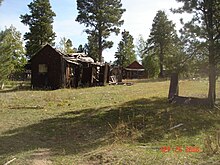Tinton, South Dakota | |
|---|---|
Ghost town | |
 Shaft House near Tinton | |
| Coordinates: 44°22′50″N 104°02′55″W / 44.3805398°N 104.0485446°W[1] | |
| Country | United States |
| State | South Dakota |
| County | Lawrence |
| Founded | late 1800s |
| Abandoned | 1950s |
| Elevation | 5,961 ft (1,817 m) |
| Population (2013) | |
| • Total | 0 |
| Time zone | UTC-7 (MST) |
| • Summer (DST) | UTC-6 (MDT) |
Tinton is a ghost town in the Black Hills of Lawrence County, South Dakota, United States. Founded in 1876, it started out as a gold mining camp and later began to produce tin. It had a heavy decline in the early 20th century due to the decline in the mining industry, and the town was fully abandoned by the 1950s.[2]
History[edit]
The area was first settled in 1876 by Edgar St. John, who lived in the town until his death in 1928. That same year, tin was discovered in the area in placer deposits. In 1879, large gold deposits were found in Negro Hill, just south of the present-day town site. This discovery caused the first boom of the area. In 1884, tin was discovered within pegmatite rock, furthering the development of the area and converting the operation from gold to tin.[2]
A mining company known as the Tinton Company had established Tinton as a company town by 1904. Over several years, other companies took ownership of the town, including The American Tin Plate Company, The Boston Tin Company, The Black Hills Tin Mining Company, and The Tinton Reduction Company.[2] The mining facilities ran right up against the town.[3] The town had a post office, bank, mill, two-room schoolhouse, hotel, Black Hills Tin Company store and office, assembly hall, blacksmith, grocery, weekly newspaper, and six houses for miners and their families. At least 14 more houses were added over the years. It was once proposed that a railroad be built to the town from Iron Creek in Spearfish Canyon, but this was never accomplished. 104,987 pounds (47,621 kg) of tin had been mined from the Rough and Ready Mine alone by 1911.[2]
From there, production began to decline, but continued in short bursts of activity until the 1950s. Other mining operations in the area were also very successful.[2] In the 1930s, a sawmill was built due to the declining success of the town's mining operations. During World War II, the mine briefly resumed operations and began producing feldspar, lithium, and more tin.[2] However, the mines were operating at a loss and shut down again within the decade.[3]

The town was abandoned after a fire destroyed the mill in the 1950s. Today, the town is managed by the mining company Tinton Enterprises. The mines are now back in operation, providing tantalum.[3]
Geography[edit]
Tinton is located at the back of Spearfish Canyon in the Black Hills of Lawrence County, South Dakota, and Crook County, Wyoming. The historical Main Street ran down the Wyoming-South Dakota state line, but the town is most widely accepted to be inside the latter. It is approximately 6 miles (9.7 km) west of Iron Creek. Tinton is set up on a hill and overlooks the valleys to the east and west, which are full of mines.[2] Modern access is via National Forest Road 222. Several other ghost towns, including Mineral and Welcome, Wyoming, are located nearby.[3]
While many structures are still standing, several have collapsed, and there is no glass in the windows. The modern mining operation replaced the Wyoming-side structures with new buildings; historically, the Wyoming side of town included the hotel, school, post office, and blacksmith. These were all destroyed in 1996. The South Dakota side, while mostly left untouched by demolition,[3]
References[edit]
- ^ a b "Feature Detail Report for: Tinton." USGS. U.S. Department of the Interior, U.S. Geological Survey., 13 Feb. 1980. GNIS. Web. 23 Aug. 2013.
- ^ a b c d e f g Parker, Watson, and Hugh K. Lambert. Black Hills Ghost Towns. First ed. Vol. 1. Chicago, IL: The Swallow Press Incorporated, 1974. 188-91. 1 vols. Print.
- ^ a b c d e Raisch, Bruce A. (2006). "Wyoming Black Hills Ghost Towns". Ghost Towns and Other Historical Sites of the Black Hills (4th ed.). Virginia Beach, Virginia: Donning Company Publishers. pp. 96–100. ISBN 978-1-57864-351-6.


